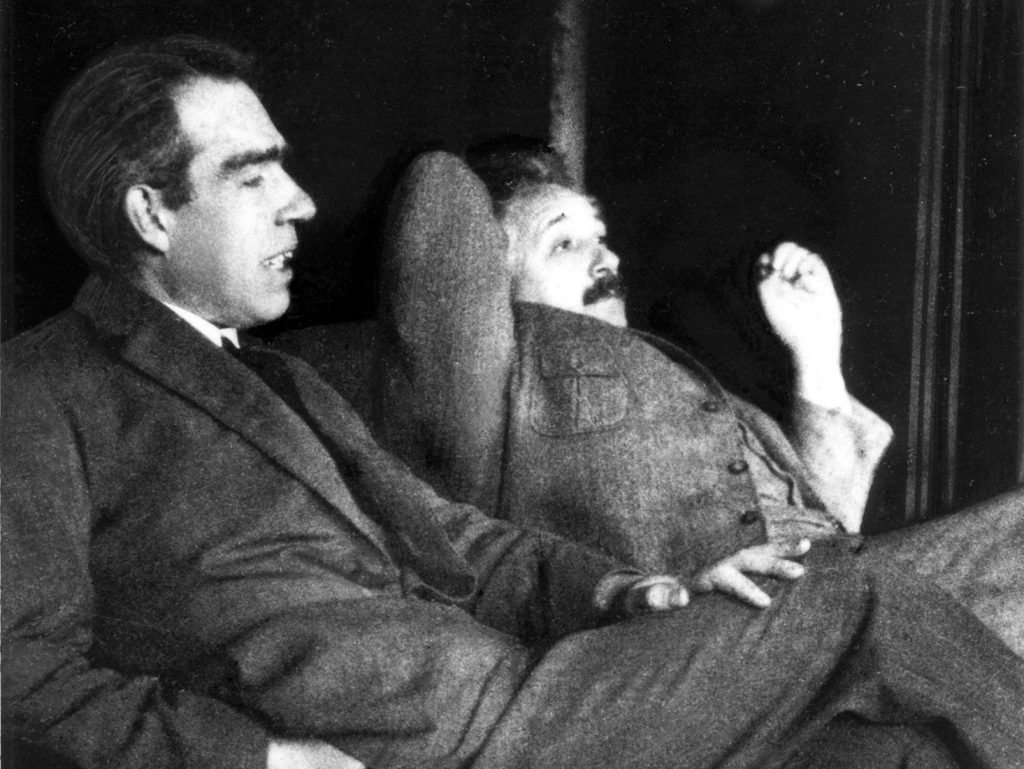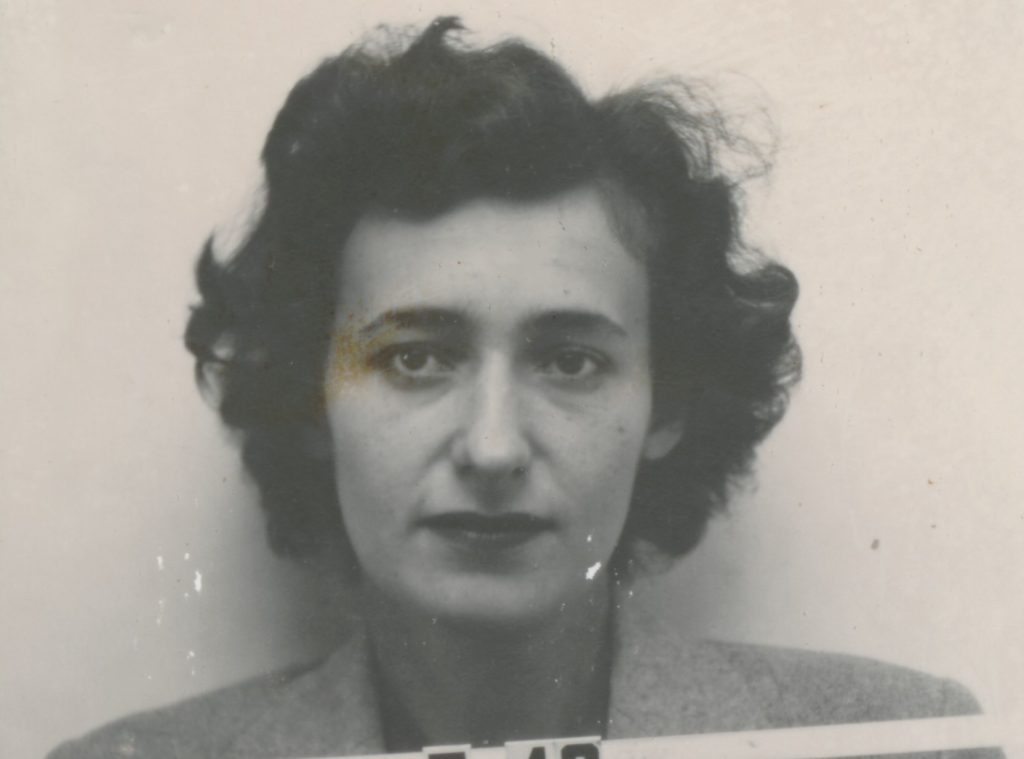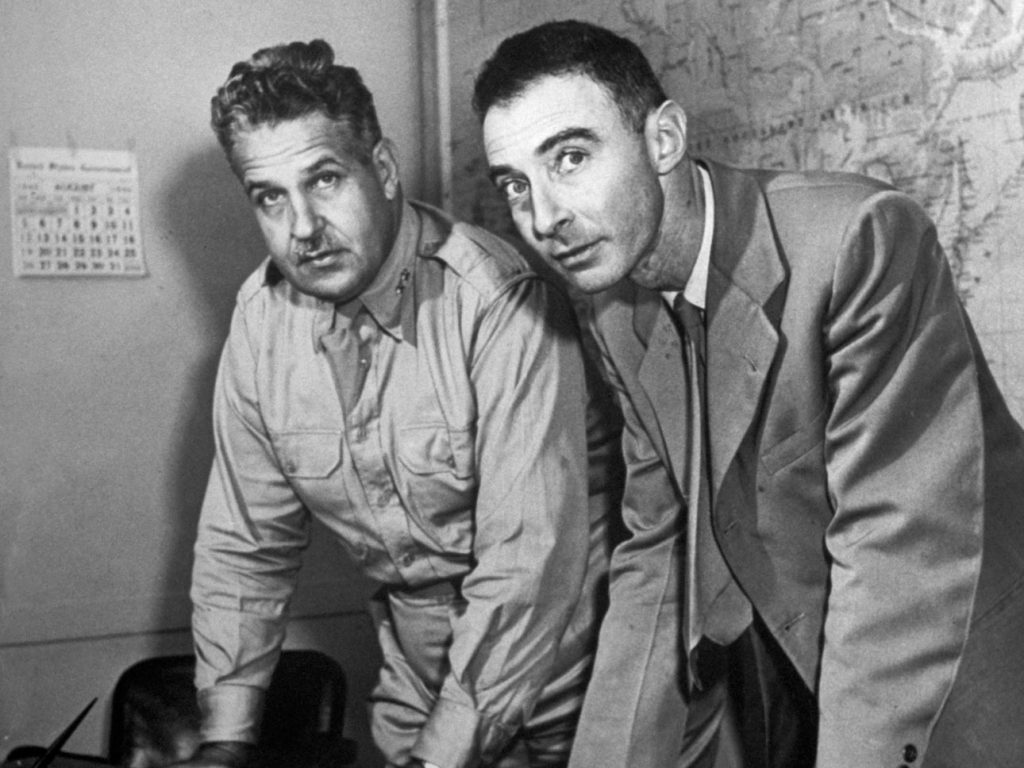Christopher Nolan’s “Oppenheimer” has made physics sexy again. For me, the film was an absolute highlight because many great physicists of the 20th century and quantum mechanics made guest appearances – gold for a fangirl like me! I went to the cinema with my physicist friends and afterwards, we discussed who we recognised. But there were also some details in the film that perhaps not everyone noticed or that there was more to them than meets the eye. That’s why I’m sharing ten things with you today that you may have missed in Oppenheimer.
Note: The article contains spoilers. However, as this is a historical film and most people know roughly what happened at Los Alamos, the spoilers are not too big. However, it’s still worth watching the film before reading the article, as I often refer to specific scenes.
1. Niels Bohr was the superstar of physics
The young Oppenheimer meets Niels Bohr at the beginning of the film when he gives a lecture in Cambridge. Although many names are perhaps better known today, Bohr was the superstar among the superstars of physics at the time. Oppenheimer was in his early 20s from 1924 to 1926 in Cambridge and Bohr had just won his Nobel Prize. He received it in 1922 for the discovery of Bohr’s atomic model. His model is still popularly taught in schools today; it states that electrons orbit the nucleus of an atom on “planetary orbits” and obey mystical rules. At the time, nobody knew where these rules (Bohr’s postulates) came from. This was only clarified a few years later with the development of quantum mechanics.

Bohr was part of the Manhattan Project but mainly worked as a consultant. He fled from the Nazis during the Second World War, as his mother was Jewish, via Sweden to Scotland. He first visited Los Alamos (where the Manhattan Project was researching the atomic bomb) in 1943 and worked there under the pseudonym “Nicholas Baker” for security reasons. He did not stay there but visited the laboratory regularly over the next two years. Bohr said they didn’t need his help to build the bomb. Oppenheimer, on the other hand, believes he made significant contributions to working out the role of neutrons. Bohr was seen by many as a “scientific father figure”. This is also hinted at in the film when he is cheered during a visit to the Christmas party.
2. Oppenheimer predicted black holes

The film is so much about the atomic bomb, spies and war that one small detail at the beginning of the film can be overlooked: Oppenheimer, during his time at the University of California at Berkeley, predicted the existence of black holes together with his student Hartland Snyder. Many people only think of Albert Einstein and Stephen Hawking when they think of this topic. Although black holes are a direct consequence of Einstein’s general theory of relativity, he opposed this and wrote an article in 1939 stating that black holes were impossible. Only months later, Oppenheimer and Snyder published their paper “On Continued Gravitational Contraction“, in which they predicted – based on Einstein’s field equations – that when a heavy star runs out of fuel, it collapses into a black hole. The model is now known as the Oppenheimer-Snyder model and is regarded as the first prediction of black holes, even though the word was not invented until 1967.
3. Richard Feynman plays the bongos and sees the explosion with his own eyes
One little Easter egg that I was very happy about was the bongo solo of a person shortly after the explosion of the atomic bomb “The Gadget” during the Trinity test. Of course, fan girls and boys know immediately who that is: Richard Feynman. He once said that when he was invited to play Bongo, many people didn’t even bother to mention that he was also a theoretical physicist. He plays them twice in the film: after the explosion and at the Manhattan Project Christmas party.
Feynman was one of the youngest members of the Manhattan Project: he was born in 1918 and was just 27 years old at the time of the Trinity Test. He was offered the opportunity to travel to Los Alamos even before he had his doctorate. He completed his doctorate at Princeton shortly before his departure.
“Oh, so all this stuff is for you!”
Feynman was a real jokester and particularly witty: many scientists travelled from Princeton to New Mexico. To keep the project secret, they were told not to travel there directly, as it would be too conspicuous. Feynman thought to himself: “If nobody is travelling from Princeton, one ticket will hardly attract attention. So he bought a ticket from Princeton to New Mexico and the man at the ticket counter said: “Oh, so all this stuff is for you!”. They’d been carting containers full of equipment into the desert for weeks and no one had bothered to think that it might be conspicuous.
In the film, Feynman is conspicuous for another detail. Almost everyone watching the explosion of “The Gadget” is wearing glasses with black lenses. Feynman thought to himself: At a distance of 32 kilometres, you can see absolutely nothing with black glasses. The only thing that could damage the eyes was UV radiation. So he got into a jeep, with the windscreen to protect him, as UV radiation cannot penetrate glass. He took off his glasses and said he was the only person who saw the explosion with his own eyes.
4. There were women in the Manhattan Project
Physics is a male domain, even more so in the 1940s than today. However, there were far more women than “Oppenheimer” suggests: 640 women worked at Los Alamos, or 11 per cent. Not all of them were typists, but almost half of them were scientists. Only one can be seen in the film: Lilli Hornig. She makes two appearances: first she announces that “typing” was not taught in the chemistry programme at Harvard, and then she discusses how her reproductive system is better protected against radiation than that of men. Unfortunately, that’s all there is.

Hornig, née Schwenk, was also a young 24-year-old at the time. She came to Los Alamos with her husband Donald Hornig and, as shown in the film, was accepted into the scientific team. However, after the discussion about the influence of radiation on the female body, Hornig was transferred to the department that dealt with the construction of the explosive lens (more on this under point 8). After her time at Los Alamos, she completed her doctorate at Harvard. During her academic career, she campaigned for the rights of female scientists. In addition to Hornig, Maria Goeppert Mayer also worked at Los Alamos – the second woman ever to be honoured with the Nobel Prize in Physics.
5. They tried to protect the most dangerous bomb of their time with a pile of mattresses
Another cute detail can be seen when the detonation of the bomb is being prepared for the Trinity test. Workers hoist the bomb “The Gadget” onto a 30-metre-high steel tower – and place a pile of mattresses underneath. They are handling the most dangerous weapon of its time, filled with 6.2 kg of plutonium-239, and if it falls, it will be caught by a pile of mattresses? That’s not a film mistake, it was actually the case. I wonder if that would have been of any use if the atomic bomb had crashed to the ground at full height …
6. Nobody knew how powerful the bomb would be
While the members of the Manhattan Project wait for the storm to subside so that the Trinity Test can begin, they nervously pass the time betting on how powerful the bomb will be. In other words, nobody knew how powerful the atomic bomb would actually be.
The bets ranged from zero – the bomb is a dud, by Norman Ramsey (pro hint: the discoverer of the Ramsey interferometer, Nobel Prize 1989) – to a force equivalent to 45 kilotonnes of the explosive TNT, proposed by Edward Teller, the inventor of the hydrogen bomb. Hans Bethe (co-discoverer of the CNO cycle in stars, also known as the Bethe-Weizsäcker cycle, Nobel Prize 1967) put his money on 8 kilotonnes, which corresponded to the value predicted by the theorist Emilio Segrè (discoverer of the antiproton, Nobel Prize 1959). Oppenheimer guessed a paltry 0.3 kilotonnes. The winner was Isidor Isaac Rabi (discoverer of the Rabi oscillation, Nobel Prize 1944), who predicted 18 kilotonnes. Radiochemical analyses of the crater immediately after the test showed an explosive force of 18.6 kilotonnes. However, more recent analyses from 2021 show that it was even more: a full 24.8 ± 2 kilotonnes of TNT. So presumably someone else should have won the pot!
You can also see that the Manhattan Project was a who’s who of physics! They only bought in the best physicists, many of whom later won a Nobel Prize. Oppenheimer was not one of them, probably because of his political difficulties, which were discussed in detail in the film. And Edward Teller didn’t get one either. But – brace yourselves – he did win the first Ig Nobel Prize for Peace in 1991, the satirical Nobel Prize “for his lifelong commitment to changing the meaning of the word ‘peace'”.
7. Edward Teller applies absurd amounts of sunscreen
While we’re on the subject of Edward Teller: In the film, it can be seen that he behaves differently from most of the other people on Compania Hill shortly before the explosion of “The Gadget”. Most of the men are lying on the ground with their backs to the explosion and black glasses on their noses. Teller, on the other hand, is sitting on a chair, looking straight towards the explosion, but applying a ridiculous amount of sunscreen to protect himself.
Sun cream obviously doesn’t protect against gamma radiation, I probably don’t need to tell you that. But in fact, ionising radiation, such as that emitted by the radioactive elements plutonium and uranium, only accounts for around five per cent of the total energy emitted by the bomb.

About half of the energy goes into the explosion and the shock wave. 35 per cent is thermal radiation. Like the sun, the bomb emits a broad spectrum of radiation, ranging from visible light to infrared and ultraviolet. Sun cream does indeed protect against UV radiation (or a pane of glass, as Feynman (incidentally: co-founder of quantum electrodynamics, Nobel Prize 1965) correctly thought). After nuclear bomb explosions, this thermal radiation causes burns and injuries to the eyes and can even ignite fires. In Teller’s case, however, the care was probably exaggerated. The men were more than 30 kilometres away from the explosion and the intensity of the thermal radiation decreases with distance. To my knowledge, there are no reports that other members at the test site suffered severe “sunburn”.
8. “The Gadget” was an engineering masterpiece
You’d think building a nuclear bomb would be easy. Just take enough plutonium and if you throw it from a 30-metre-high tower, it should go boom all by itself, right?
There are several subtleties that you should bear in mind. Most importantly, you don’t want it to go boom too early. That’s why the plutonium-239 is only compressed at the moment of detonation to such an extent that a critical mass is reached at which nuclear fission continues abruptly in the form of a chain reaction and the bomb explodes. The bomb consists of further layers, uranium-238, boron and aluminium, which are ultimately good for ensuring that the bomb does not go off too early.

I find the honeycomb-like shell of the bomb particularly impressive. This can be seen very clearly in the film. This is a polygonal explosive lens. Two types of explosives are combined, one that explodes quickly and one that explodes slowly, so that a smooth, round explosion front arrives at the plutonium sphere. This works similarly to a lens that refracts light – but with a pressure wave. This is necessary so that the nucleus is compressed quickly and evenly so that it is put into a critical state and the chain reaction can start.
9. The delay of the explosion: How far away were the observers really?
You probably noticed in the film that it became very quiet after the explosion of “The Gadget”. We see impressive images of the mushroom cloud, Oppenheimer says (or thinks) his iconic words from the Bhagavad Gita (the “Hindu Bible”): “Now I have become death, the destroyer of worlds.” It takes 90 seconds in the film for the shockwave to reach the observers. This is not a cinematic effect but is due to the fact that the observers are so far away from the explosion that the shock wave and the sound first have to travel the distance to them.
“Now I have become death, the destroyer of worlds”
There were shelters about 9.1 kilometres away from the bomb. Many of the VIPs, on the other hand, were on Compania Hill, 32 kilometres away. Sound has a speed of just under 340 metres per second. So sound needs just under 30 seconds to reach the shelter, but about a minute and a half to reach Compania Hill. Exactly as long as the silence in the cinema!

However, in the film, it looks as if Oppenheimer is in one of the shelters, while Groves and the other men, who are lying on mattresses on the floor, are on Compania Hill. But the shockwave reaches them all at the same time. Actually, reports say that Oppenheimer would be on Compania Hill with Groves and the shockwave should arrive there after a minute and a half.
10. The chain reaction that never stops is actually two
In the film, the physicists discuss a major risk of the nuclear bomb: what if the chain reaction doesn’t stop, the atmosphere goes up in flames and “The Gadget” means the end of our world? I was quite taken aback when I first heard this in the trailer.

The idea probably came from Arthur Compton (discoverer of the Compton effect, Nobel Prize 1927), which he discussed with Oppenheimer. In a nutshell, the idea is as follows: the sun draws its energy from the fusion of hydrogen nuclei (i.e. protons) into helium. This releases energy. However, this requires extreme conditions, such as high temperature and pressure. Wouldn’t it be possible for the explosion of a nuclear bomb to create these extreme conditions? And trigger nuclear fusion in the atmosphere and in the oceans, where hydrogen, in the form of gas or water, is abundant? This would release an unimaginable amount of energy: The earth would burst into flames.
“The earth would vaporise”
What annoyed me: It was formulated in such a way that “the chain reaction never stops”. But actually, the first chain reaction in the atomic bomb (nuclear fission) triggers a second chain reaction (nuclear fusion). Call me splitting hairs, but they are two different physical processes!
Either way, our planet is still here. Scientists are still struggling to get stable nuclear fusion going in reactors and – even more difficult – to maintain it. This is what makes fusion reactors so safe: if the extreme conditions of nuclear fusion break down, the reaction comes to a standstill as if you were blowing out a candle. So there was no reason to worry back then. But they could be forgiven for not knowing any better. And the physicists of the Manhattan Project certainly triggered a metaphorical chain reaction, as Einstein and Oppenheimer discussed at the end of the film.
I wrote an article for the Tagesspiegel about how Oppenheimer became the father of the atomic bomb and whether artificial intelligence is the next atomic bomb – you might also be interested in these texts. Don’t forget to subscribe to my blog to make sure you don’t miss a single post. If you like what you read, you can buy me a coffee here!


